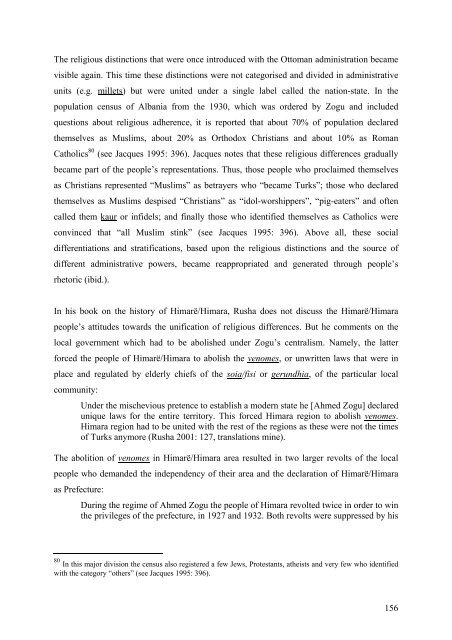university of nova gorica graduate school contested spaces and ...
university of nova gorica graduate school contested spaces and ...
university of nova gorica graduate school contested spaces and ...
Create successful ePaper yourself
Turn your PDF publications into a flip-book with our unique Google optimized e-Paper software.
The religious distinctions that were once introduced with the Ottoman administration became<br />
visible again. This time these distinctions were not categorised <strong>and</strong> divided in administrative<br />
units (e.g. millets) but were united under a single label called the nation-state. In the<br />
population census <strong>of</strong> Albania from the 1930, which was ordered by Zogu <strong>and</strong> included<br />
questions about religious adherence, it is reported that about 70% <strong>of</strong> population declared<br />
themselves as Muslims, about 20% as Orthodox Christians <strong>and</strong> about 10% as Roman<br />
Catholics 80 (see Jacques 1995: 396). Jacques notes that these religious differences gradually<br />
became part <strong>of</strong> the people’s representations. Thus, those people who proclaimed themselves<br />
as Christians represented “Muslims” as betrayers who “became Turks”; those who declared<br />
themselves as Muslims despised “Christians” as “idol-worshippers”, “pig-eaters” <strong>and</strong> <strong>of</strong>ten<br />
called them kaur or infidels; <strong>and</strong> finally those who identified themselves as Catholics were<br />
convinced that “all Muslim stink” (see Jacques 1995: 396). Above all, these social<br />
differentiations <strong>and</strong> stratifications, based upon the religious distinctions <strong>and</strong> the source <strong>of</strong><br />
different administrative powers, became reappropriated <strong>and</strong> generated through people’s<br />
rhetoric (ibid.).<br />
In his book on the history <strong>of</strong> Himarë/Himara, Rusha does not discuss the Himarë/Himara<br />
people’s attitudes towards the unification <strong>of</strong> religious differences. But he comments on the<br />
local government which had to be abolished under Zogu’s centralism. Namely, the latter<br />
forced the people <strong>of</strong> Himarë/Himara to abolish the venomes, or unwritten laws that were in<br />
place <strong>and</strong> regulated by elderly chiefs <strong>of</strong> the soia/fisi or gerundhia, <strong>of</strong> the particular local<br />
community:<br />
Under the mischevious pretence to establish a modern state he [Ahmed Zogu] declared<br />
unique laws for the entire territory. This forced Himara region to abolish venomes.<br />
Himara region had to be united with the rest <strong>of</strong> the regions as these were not the times<br />
<strong>of</strong> Turks anymore (Rusha 2001: 127, translations mine).<br />
The abolition <strong>of</strong> venomes in Himarë/Himara area resulted in two larger revolts <strong>of</strong> the local<br />
people who dem<strong>and</strong>ed the independency <strong>of</strong> their area <strong>and</strong> the declaration <strong>of</strong> Himarë/Himara<br />
as Prefecture:<br />
During the regime <strong>of</strong> Ahmed Zogu the people <strong>of</strong> Himara revolted twice in order to win<br />
the privileges <strong>of</strong> the prefecture, in 1927 <strong>and</strong> 1932. Both revolts were suppressed by his<br />
80 In this major division the census also registered a few Jews, Protestants, atheists <strong>and</strong> very few who identified<br />
with the category “others” (see Jacques 1995: 396).<br />
156

















